- Home
- Collections
- IDE J
- Port Ahuriri Bowling Club Centennial Celebration 1913-2013
Port Ahuriri Bowling Club Centennial Celebration 1913-2013
Page 1
Foreword
One hundred years ago there was the dream to build a bowling green for play in the suburb of Port Ahuriri. This man was J.P. Smith who with other built the first green with a group of men and much physical labour. Over the years we have seen various buildings change for the Club House and the increase from one green to three.
Membership has grown throughout the years with the women creating their own Club before amalgamating with the men, to become one Club.
Sadly since the middle 1980’s the membership for both men and women has drastically declined. I believe that this is for several reasons -firstly the movement of people away from the Port area and the changes in our society. People are now working at different times during the week. More mechanisation on the wharf and railways. The decline in the economic situation in the country.
Meanwhile the current members within the Club are competitive and we are represented in Centre events and teams frequently enter local tournaments. We do have success in all area and as a small Club we should be very proud of our successes and our participation.
As a Club with a long history for the Port area and the whole of Napier, I dearly hope that we may continue to attract people into the sport and to the Club and keep a fine infrastructure for the future.
I would like to thank the committee for their support and hard work in preparing for our celebrations, especially Buster Harvey. The thanks extend to all Club members who avail themselves to work to keep us going.
To outside visitors returning to the Club a big welcome and I hope you enjoy the fellowship of past and present members.
Lorraine Beaufort
(President)
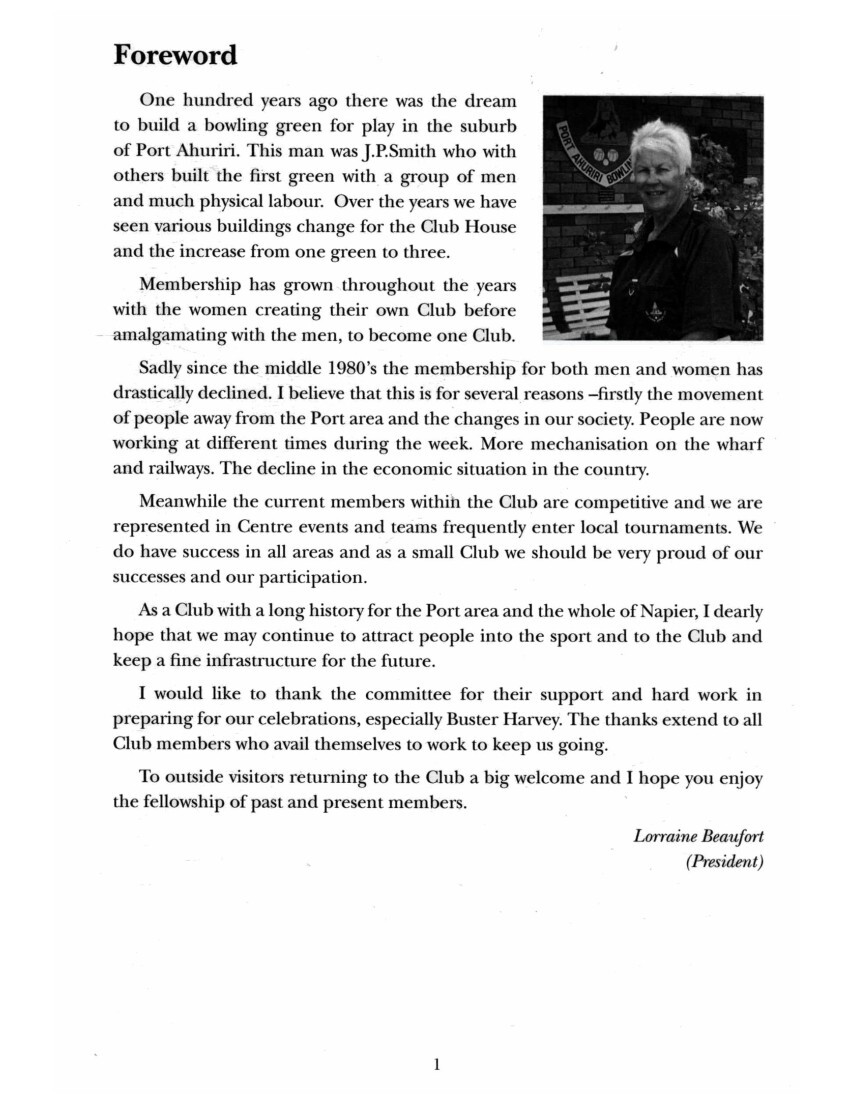
Page 3
Formation of the Men’s Club
Before there was any thought of forming a bowling club at Port Ahuriri, a private green existed there approximately on the site of the Napier Gas Company’s gas reservoir. This green was made and owned by the late M.E. Crowley and it was there that his two sons had their introduction to the game. These two were later in a team which won the dominion Championship Fours. Though this was purely a private green, it is probable that its existence provided a stimulus to the local residents to form a club and thus enable them to take part in the game.
A meeting to put this into effect was held on the evening of 5th February 1913, in the Port Schoolhouse, there being present Messer’s B.B. Creagh, P. Dolbel, J.R. Kessel, W.G. Martin, J. Myhill, C. Prebble, J. Sheehan, and A.G. Thompson. Mr Creagh, who was voted to the Chair, explained what had already been done, in an unofficial way, regarding the leasing of a section from the Harbour Board and it was resolved to proceed with the Club’s formation. A general meeting was called for the 17th February 2013 [1913], when the following Officers were elected:
President: J P Smith Vice-President: B.B. Creagh
Hon. Secretary: A G Thompson
Hon. Treasurer: W G Martin
Committee: C Prebble, F G Smith Jnr., W J Montgomery, J R Kessell, G Hale, J Sheehan, and J Epps.
During this first year meetings were held each month and great enthusiasm and energy were evinced by all members.
Work commenced immediately in filling, levelling and making a playing surface and negotiations were entered into with Messer’s Bull Bros. Builders, to erect a fence and small pavilion. One means to raise funds was the holding of a plain and fancy dress dance which apparently proved successful. Throughout the year the promoters of the club threw themselves wholeheartedly into the manual work required, even calling on members of the family to assist with the task. The result was that by the end of the year a site that had been little more than a tide wash was converted into an area suitable and ready for the ancient game of bowls. Inspired by the enthusiasm and work of the President, Mr J.P. Smith members developed the spirit of self-help, thus keeping expenses to a minimum. It was inevitable that funds should be required and many of the members acted as guarantors at the Bank for an overdraft to meet the cost of the initial preparations.
Thus the foundations of our club were well and truly laid.
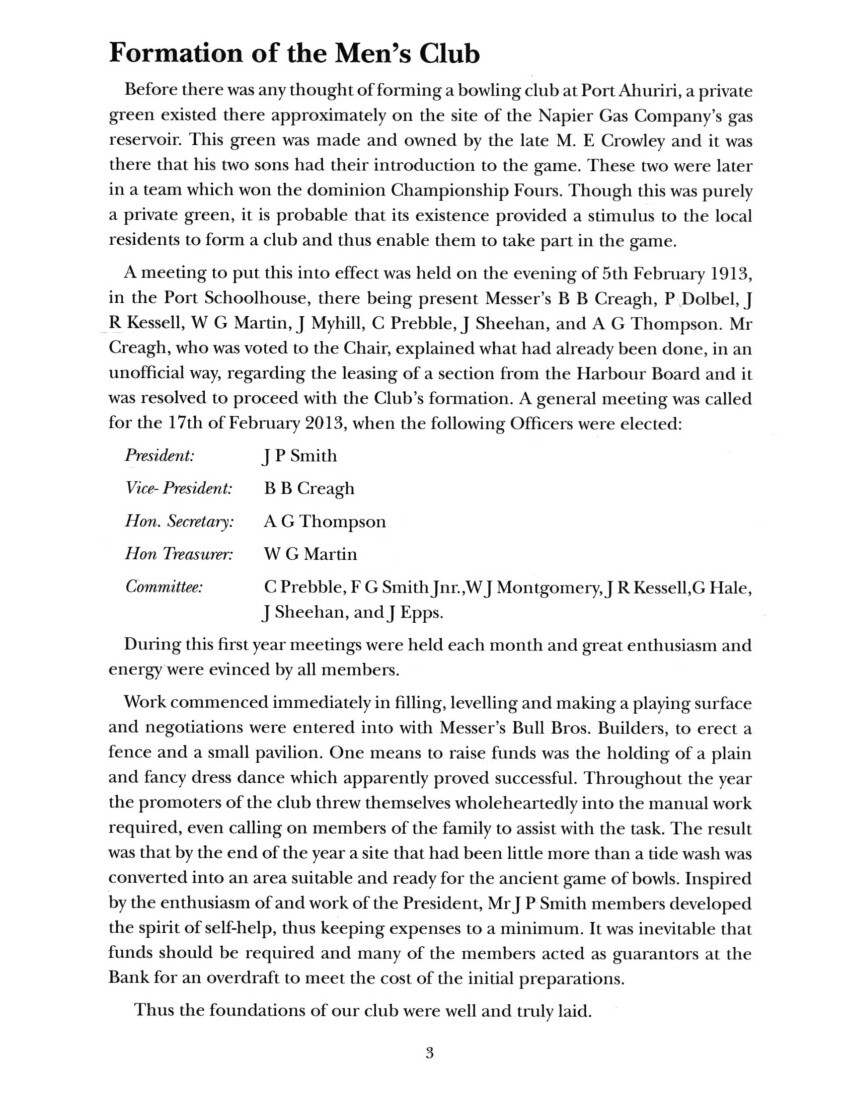
Page 5
Acquisition of Grounds
The first section of land acquired was that leased on 22 January 1913, from the Napier Harbour Board and situated on the corner of Battery Road and Coronation Street. This was section 149 (Now C. Green), leased on the perpetual system to Mr B.B. Creagh and has an area of 1 rood 16.3 perches. The rental was £15 per annum with the right of renewal every 21 years. This lease was renewed on the 22 January 1934, at a rental of £15 per annum and again in 1955 at £24 per annum. It was originally leased by Mr B.B. Creagh and the lease remained in his name until 1923, when it was transferred to the Club.
Section 150 was leased on the 15th December 1915, at a rental of £9 per annum. This comprised an area of 32.3 perches and was acquired for the purpose of laying a croquet court for use by the ladies, many of whom were member’s wives. This lease was renewed in 1936 and again in 1957 at a rental of £14 10/s per annum.
The next acquisition of land took place on the 22nd December 1924 when the Club leased four adjoining sections, Nos 155, 156, 157, and 158 at a rental of £7 10/s each per annum. As the Club found itself unable to finance the rental of all these additional sections, two of them, Nos. 157 and 156 were disposed of to local buyers. Section 157 and 158 (Now B Green) each containing 21.1 perches were retained at a rental of £15 per annum and in 1945 the lease was renewed at a rental of £15 per annum. The fourth acquisition occurred on 20th August 1934, when a lease obtained of land (This is our paths and includes A Green).
The rental for this area of 2 roods 00.7 perches was leased for the then proposed No.3 green. The rent for this was £1 per annum for the first ten years and £9 per annum for the following eleven years.
At the end of this, our fiftieth year, the total area of Club’s grounds is 1 acre 1 rood 31.5 perches on which the annual rental (in 1988) was £58.
A plan is attached showing details of the various sections referred to and it may be of interest to members to know that (in 1958) the Napier City Council’s intention was to provide a roadway running parallel to Battery road from Coronation Street at the rear of No.3 Green (now A Green). This is now Tangaroa Street. Obviously during subsequent years the greens have been renumbered, Green No. 1 being adjacent to the new roadway Tangaroa Street with Green No. 2 being adjacent to Battery Road, whilst Green No.3 is on the corner of Battery Road and Coronation Street.
Following the wind up of the Harbour Board (which prior to be dissolved had become the Hawkes Bay Harbour Board) the ownership of the land passed to the Napier City Council. The concession cost of the current lease is $1500 per annum.
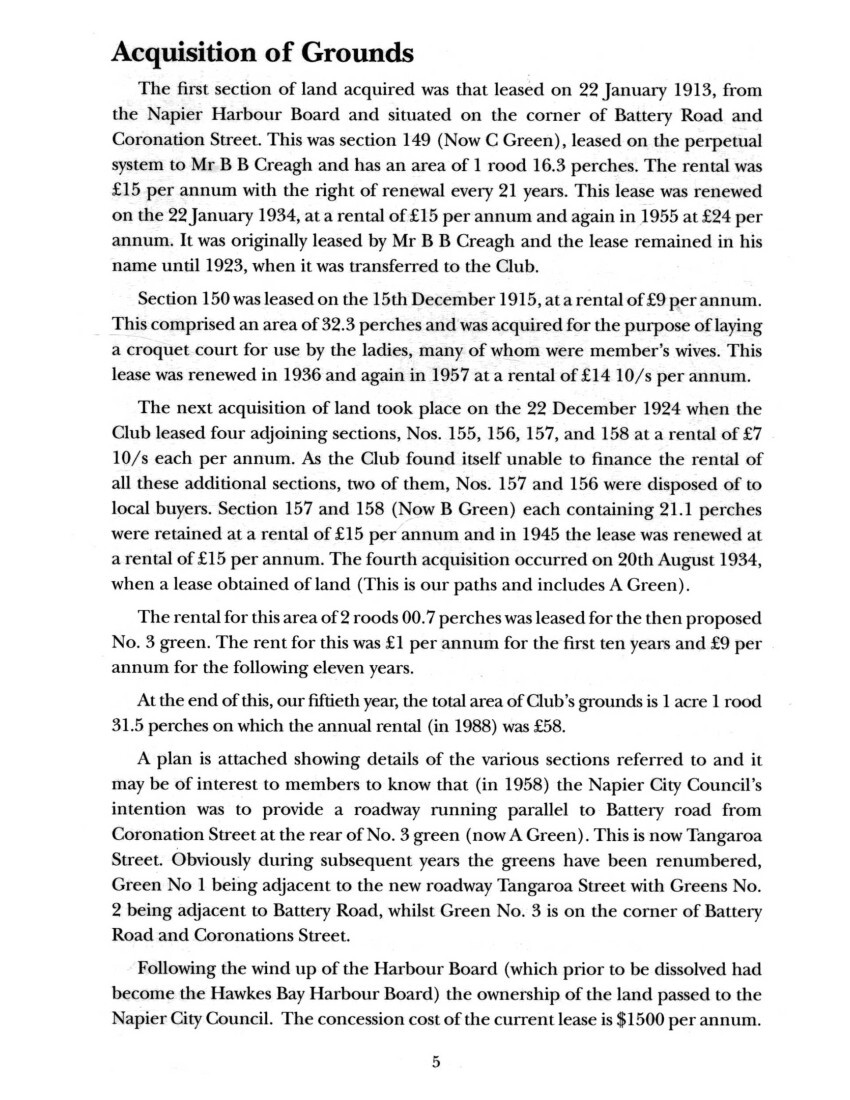
Page 6
Opening of the Port Ahuriri Bowling Club season c. 1914 by Mr & Mrs J.P. Smith.
Official Opening of First Green
This was held on 29th November 1913 and it is unfortunate that no record of that event was made in the minutes, nor can any record be found in the extant files of the Napier newspapers. However it may be gathered from two enlarged photographs, that the weather on that day was appropriate to the occasion and that about 80 men and about 50 ladies were present. There were the customary speeches, a sumptuous afternoon tea was provided by the wives of members and all the males present enjoyed their first game of bowls. It was truly a remarkable achievement for such a result to be obtained within the space of ten months on what had appeared to be such an unprepossessing piece of land. All credit for this was due to the untiring efforts of the President and the Club’s pioneer members.
It may be of interest to present day members, to know that this green was regarded as one of the two best in Hawkes Bay, the other being St Leonard’s No. 1 green at the Heretaunga Club in Hastings. It remained so until the upheaval of the 1931 earthquake. The nice compliments contributed from time to time
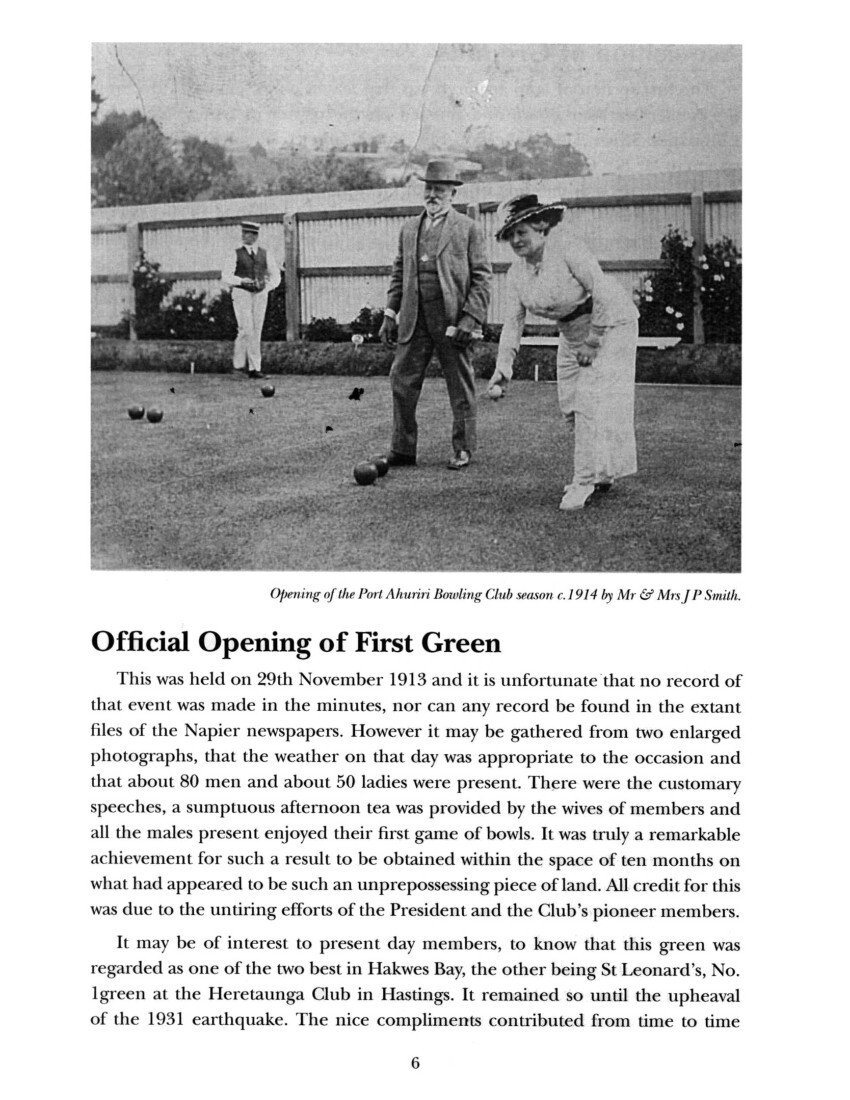
Page 7
were pleasant to our President who had supervised the laying and levelling of the greens and his services were sought in and outside the district. These were freely given without expectation of payment or refund of expenses incurred.
The severe earthquake on 3rd February 1931 brought the remainder of that season to an abrupt ending. The greens were left in a pitiable condition with cracks and terraces and in part of C green a subsidence of two feet (60 cms). At a meeting held on 22 April it was decided to take immediate steps to reconstruct them and Mr P. Barlow was asked to obtain new levels. By July, two cheques from the NZ Bowling Association amounting to £120 were received to help with the reconstruction. This was the result of a levy made by the N.Z.B.A. on all other club members in addition to this sum the Ladies Croquet Club contributed £20. The total estimate of repairing the damage was £330.
The huge task of reconstructing the greens is further evidence of what can be done on a voluntary basis by willing members, as, thanks to our then Green’s Superintendent, Mr L. Steele and his assistants, the greens were ready for re-opening on the 7th November in the same year, a truly remarkable performance.
After 100 years and the countless hours, usually without pay, provided by many greenkeepers, our greens still receive regular complimentary comments and are used by our Bowls Hawkes Bay Centre, for many of the championship tournaments.
Buildings
During the first year Messer’s Bull Bros. were given the contract to fence in (C Green) being section 149 and erect a small pavilion at a costing £150. The construction of the pavilion provided housing for member’s bowls, a “Library” and other amenities. This building still stands at the rear of C Green (which was the original No.1 playing green). Within two years of the Club’s formation, a sum of £600 had been expended, yet by the third AGM in August 1915, the liabilities had been reduced to £160.
During 1918 a pavilion and tea kiosk were erected at the site on the Battery Road frontage of what is now B Green (which was the original No.2 playing green). This building and amenities were demolished in 1937 when a substantial two-storied pavilion was built.
The cost of the fine new building, including furnishings, was £700. This was made possible by member’s contributions and by a large amount of voluntary work under the direction of the late Leo Cuff.
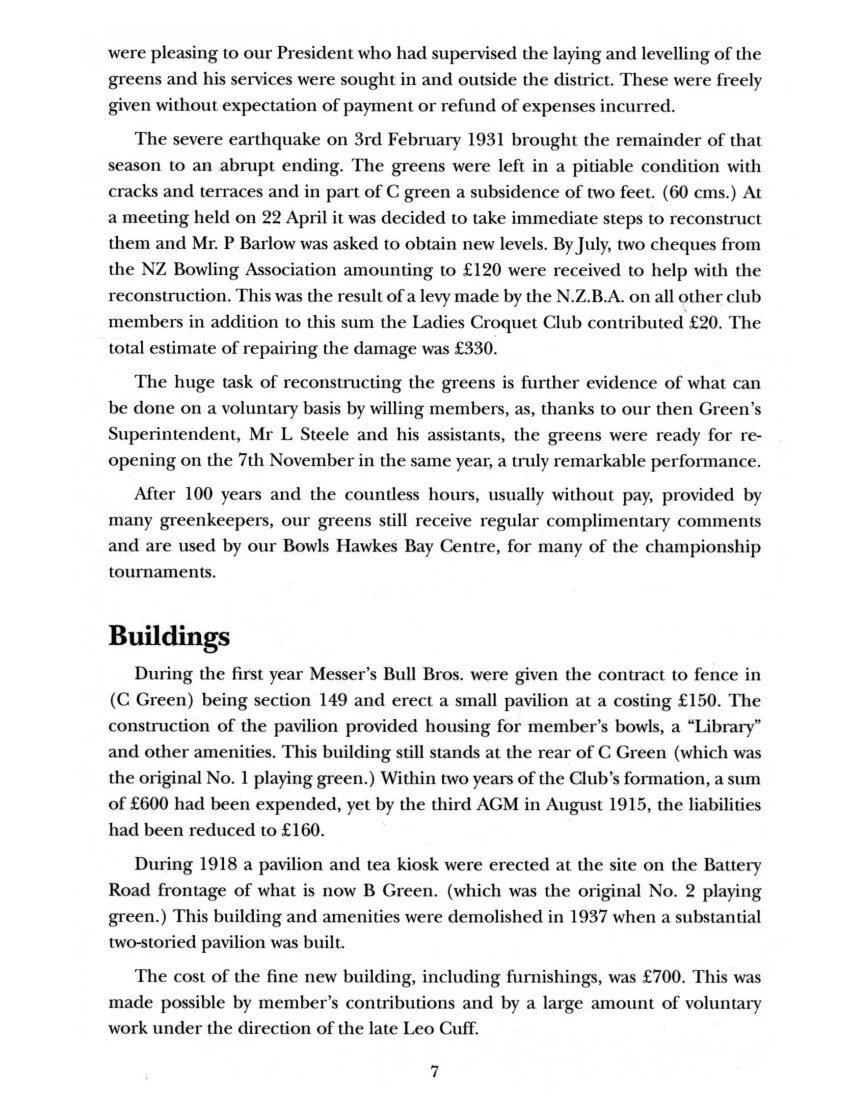
Page 8
It was very fitting that the Club decided this building to be known as the J P Smith Pavilion 1937. As its name indicates it was a monument to the memory of the first indefatigable President, who after being in this office for 14 years became Patron of the Club until the time of his death in 1946.
During the season in 1962 a small building was erected with concrete blocks at the rear of C Green to provide suitable toilets for members. Again voluntary effort was forthcoming and the Club pressed its warmest thanks to those who helped for the excellent job made. The saving to the club was substantial. These toilets remain in use today as the Men’s outside toilets.
During this time flood lighting of B green was completed which permitted evening play. During the 1962/63 season when this was first put to use, the revenue from it was approximately £130, so, as well as being a useful amenity, it was a very profitable asset from a financial point of view. Subsequently, the flood lighting was removed and sold.
The Greenkeeper’s shed was built in the 1950s at the southern end of A Green and further added to after 2005 to keep up with the necessary requirements for storing chemicals. The umpires shed was built after the main clubrooms were built in the late 1970s.
The New Pavilion
Provision of a new modern pavilion was first debated in 1971 and a building committee formed. The committee worked very hard getting ideas, sketches, plans
Photo caption – The new pavilion, opened in October 1974.
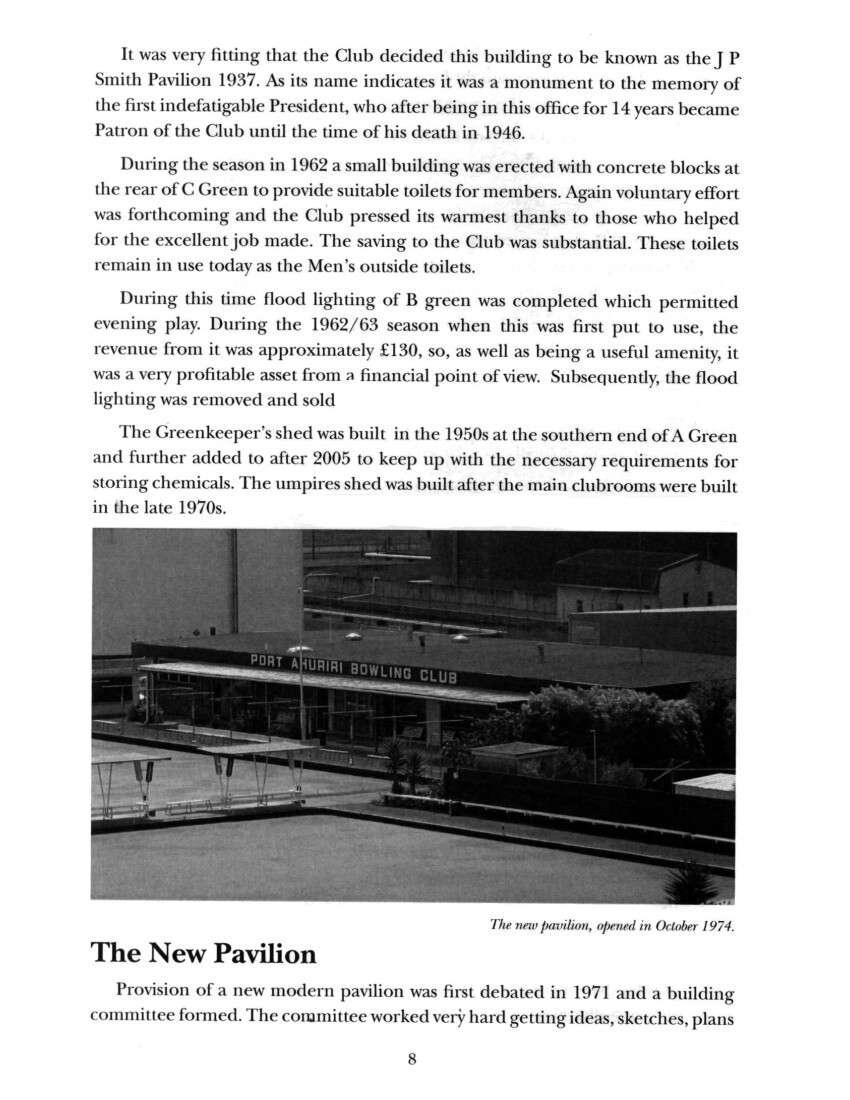
Page 9
and costings for what would be best for the Club. At a Special General Meeting in June 1973 it was moved that the Club be authorised to raise $20,000 by way of debentures to finance the project along with $7,000 already in hand.
Final plans were approved and put out to tender to lay the concrete floor, build the frame and cover it in. Volunteers from many trades came forward to do the finishing work inside which included the bar area, electrical, painting and wallpaper hanging.
The building was officially opened on Saturday 4th October 1974 by the then Deputy Mayor of Napier Mr. P (Peter) Cox. A pergola, or covered walkway was erected the following year at a cost of £1,800 [$1,800].
The position of the new pavilion was probably the factor in relabelling the three greens. That is No. 3 green became A green (being in front of the new pavilion) No. 2 became B green and No.1, (now being the furthest away from the pavilion), became C green.
The Ladies Section retained their facilities in the old Pavilion on the Battery Road frontage. However in 1978 the Napier City Council approved extensions to the new pavilion to accommodate the ladies. This consisted of their own lounge area and a locker room with its own entrance from the greens.
Once again volunteers played a big part in finishing after contractors had erected the frame and covered in. This project was financed by an overdraft from the bank and was actually repaid before the Club repaid all the debentures owing on the main building.
After much discussion between Committee and Special Meetings, it was decided to dispose of the old pavilion fronting Battery Road. It was taken away by the successful tenderer. We understand that all, or most, of the building is now the single-storied Bay View Scout Hall.
The old Pavilion concrete slab is still obvious today and many wondered how all the club and its members coped in such a small area.
Prior to the new pavilion, which opened in 1974, the Bar area was housed in what is now the greenkeepers storage building (and includes the ladies outside toilet) at the rear of C green. We are told that many wonderful fun times were had in the old Bar, affectionately known as “The Do Duck Inn”.
Shelters were erected between A and B greens in 1976 and were designed to allow scoreboards to be fixed to same. More shelters were erected between B and C greens in 1977 and the Battery end of B green in 1986.
In 1985-86 the Club borrowed $30,000 from the bank to upgrade the interior
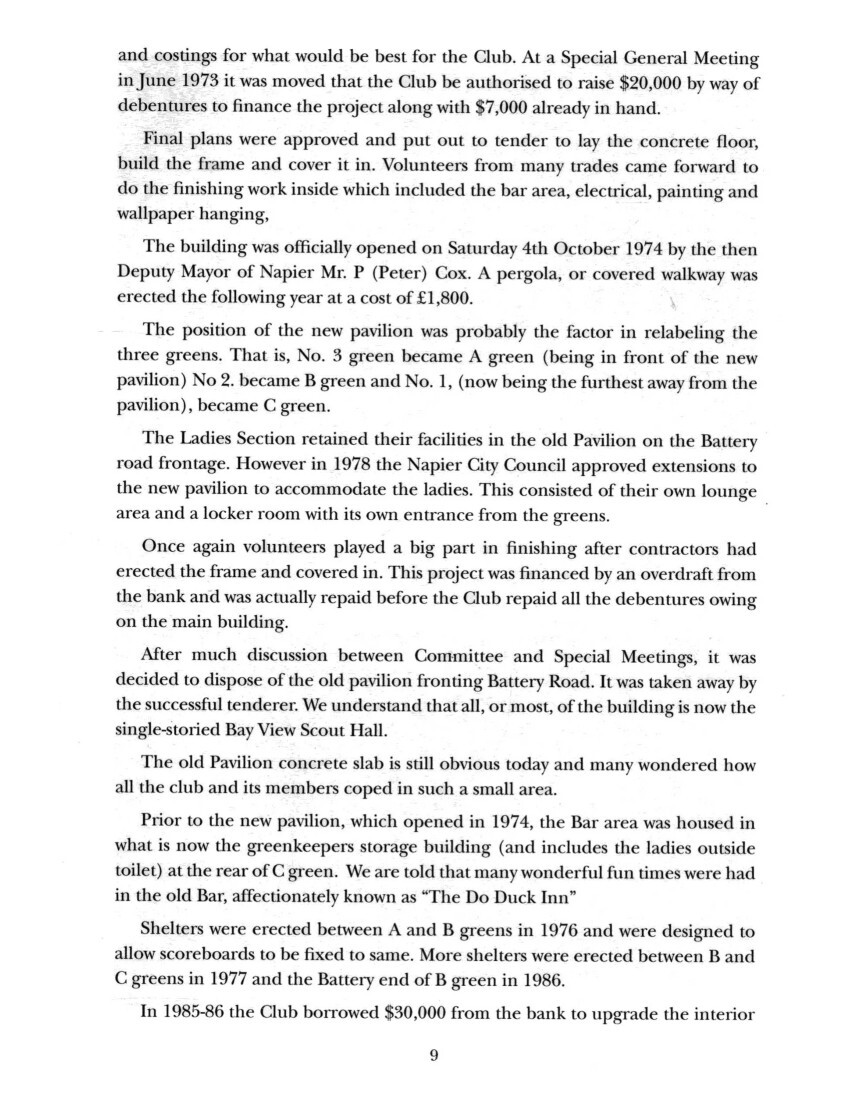
Page 14
of the Pavilion. This included new chairs and tables in an enlarged bar lounge area with new floor coverings, general redecorating and modernising the kitchen. Within the past five years further redecorating and new carpet has been laid in the bar-lounge area.
The kitchen area continues to be of a high standard with good work benches, stoves, fridges, freezers, dishwasher and boiling water unit. This helps to attract use of the pavilion by interested groups for social occasions.
Social Activities
In the early years the lady members made afternoon tea and played cards. Indoor bowls were played in 1954 and for a few years after. In 1998 Ray and Shirley Mabel [Mabey] introduced Housie on Saturday afternoons during the winter months. This was taken over in 2001 by Ron White and his helpers, and continues to date.
These events during the winter months were for the purpose of keeping members in touch and as a great way of earning monies for the Club, which over the years has been considerable. The winter months have also seen dances, pot-luck dinners, coffee mornings and a visiting local concert party.
Greens
The club takes pride in its greens and have been fortunate in having had good and committed greenkeepers and green superintendents. Turf Culture NZ
Photo caption – The present day C-Green in use during the 1940s.

Page 15
continues to keep the Club informed and this support and advisory role is a factor in having maintained our lawn greens to a respected and high standard.
In 1986 the Club approved the installations of an automatic watering system which was progressively extended to provide cover for all three greens.
It is noted that in April 1964, the club received 50 bags of Cotulla groovings from ‘up north’. The cost was £41 and delivery time to Napier took three weeks.
Cotulla had been preferred lawn type until Starweed was introduced by the late Les Burt, our greenkeeper between 2002 and 2004.
Currently A and B Greens are about 50% Cotulla and 50% Starweed with C Green having that mixture plus some Maniototo grass. Generally, Starweed is acknowledged as being better able to manage heat than the other grasses and requires less maintenance.
The current green superintendent is Geoff McGarva, who took this role last year, after eight years of valued service as Greenkeeper, for which he was paid a very small nominal salary. His dedicated service at a small cost has been acknowledged as a key factor in us maintaining the financial viability of the club in recent demanding years. our present Greenkeeper is Steve Carlaw.
Years ago B-Green was also used as a croquet green. The croquet club members shared the old two-storied pavilion and of course, like other members enjoyed the bar housed in the “Do Duck Inn” which is now a storage shed.
Port Ahuriri Women’s Bowling Club
The background begins with the formation of a Croquet Club from which its foundation members were originally recruited. This club commenced during the 1918-19 season on two greens (later 3 greens) in front of the club house (section 150 and 158).
The 1931 earthquake caused the closure of two croquet greens.
On 23 November 1938 a Special Meeting was held and made the decision to formulate a new Women’s Bowling Club which was opened in December with 50 lady members.
During the first two years croquet and bowls were played side by side until 1943 when it was decreed that no more provision for croquet would be made.
From the very early beginnings the ladies have been well recognised for their catering of morning and afternoon teas, and over recent years for lunches for major tournaments, which gain favourable comments from visiting bowlers.

Page 16
The ladies playing on C Green in the 1940s.
Much of the money raised through catering was donated to the men’s club to assist them with their reasonability for the grounds, greens and buildings.
Unfortunately the ladies clubs records, prior to moving into the new clubhouse in 1974, have been lost. Life member, Mrs Tess Oliver, who joined the ladies club 57 years ago, recalls that the ladies were very active, with a number, including herself, winning Hawkes Bay and East Coast Championships and attending National Tournaments. Tess played as a Hawkes Bay representative at Christchurch and Nelson.
In those times the numbers of men bowlers far exceeded lady bowlers.
During the winter the former two-storeyed clubhouse was utilised as a venue for indoor bowls. There were many involved with this indoor sport.

Page 17
The sound reputation of the “Port” for being very hospitable has been built with assistance from the ladies, particularly for their well respected catering skills.
Tess Oliver recalls that at a time when the greens were particularly busy, 16 senior women bowlers, who lived in, or around the Marewa area, left and established the Marewa Women’s Bowling Club on Marewa Park, in Herrick Street. One of their number, Cis Winstanly, became a national champion, and her many national achievements were acknowledged when she was honoured by being admitted to the Hawkes Bay Sport Hall of Fame, which is located in the Pettigrew Green Arena in Taradale.
The women’s club ceased operating when the ladies joined the men in an amalgamated Port Ahuriri Bowling Club, in 2005.
Amalgamated Club
In 2005, under a directive from Bowls New Zealand men’s and women’s club were required to amalgamate.
A Bowls NZ representative visited Hawkes Bay and spoke with the men’s President and vice President, giving them advice on the course they should take for a smooth joining of clubs.
After both ladies and men’s committee met to discuss the amalgamation, a joint meeting was held to explain each club’s views.
Although neither the men nor women were in favour of the move, it was obvious that Bowls NZ was continuing to push for amalgamation, so it was decided to hold a Special Meeting, to explain the situation to all club members and vote on amalgamation, which was approved.
The outcome was that at the AGM on 26 June 2005, the women were welcomed into the amalgamated club.
The Bowls NZ representative visited Hawkes Bay at a later date and commented on the fact that our amalgamation had been one of the smoothest in New Zealand.
Club Patrons
Available records confirm the following men served as Club Patron in the years indicated:
1927 – 1947 J P Smith
1947 – 1956 K McLeay
1956 – 1962 R V McCarthy
1962 – 1969 E C Pirie
1969 – 1981 M Kalin
1982 – 1991 F S Salamonsen [Salamonson]
1991 – 2004 Ralph Alexander
2004 – to date Ray Bartlett
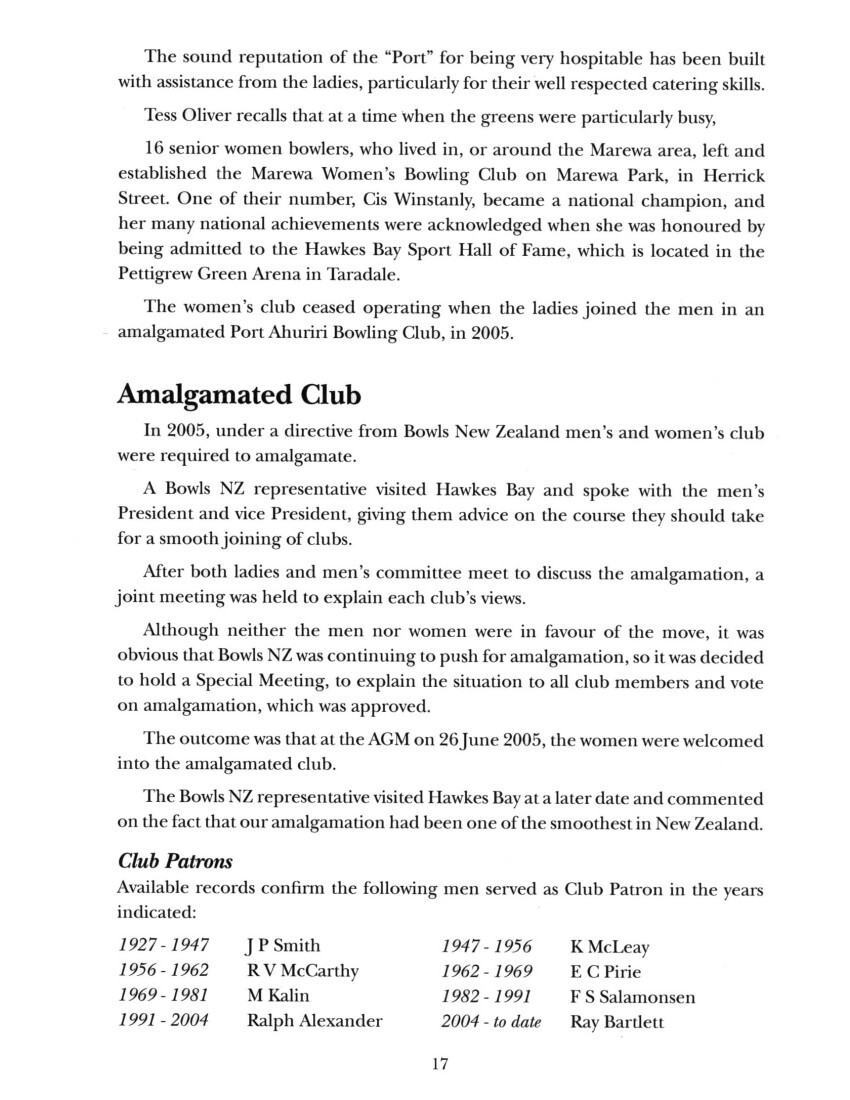
Page 18
Identifying the Ladies Club’s Patroness and their years of service has been difficult, however the records show the Patroness for the following years:
1974 – 1975 Mrs E Logan
1976 – 1977 Mrs M McCarthy
1984 – 1985 Mrs G Plows
1989 – 2007 Mrs T McKee
Club Presidents
The following have served as President in the Men’s (and later the Amalgamated) Club:
1913 – 1926 J P Smith
1927 – 1936 Harry Mayo
1936 – 1941 R V McCarthy
1942 – 1945 G B Poppelwell
1945 – 1952 M Kalin
1952 – 1954 W J Phillips
1954 – 1956 F D Logan
1956 – 1959 L Albrecht
1959 – 1961 S Smith
1961 – 1964 D Finnegan
1964 – 1967 V M Sarah
1967 – 1968 J W E Mitchell
1968 – 1972 K A Falvey
1972 – 1974 F S Salamonsen [Salamonson]
1974 – 1975 C E Evans
1976 – 1979 D C Ancell
1979 – 1982 J H Garnham
1982 – 1986 George Paget
1986 – 1988 Jack Rattray
1988 – 1990 Ray Mabey
1990 – 1992 Noel Churchhouse [Churchouse]
1992 – 1994 Ray Bartlett
1994 – 1996 Ray Mabey
1996 – 1998 Colin Durham
1998 – 2000 Robin Bryce
2000 – 2002 Merv Buxton
2002 – 2003 Buster Harvey
2003 – 2005 Frazer Daly
2005 – 2008 John McKay
2008 (to date) Lorraine Beaufort
The following have served as President in the Women’s Club since it was established in 1939 up until the amalgamation with the Men’s in 2005:
1939 – 1944 Mrs C McCarthy
1944 – 1952 Mrs H MacKay
1952 – 1954 Mrs D Shirley
1954 – 1957 Mrs E Logan
1957 – 1962 Mrs M Hardaker
1962 – 1963 Mrs M Paterson
1963 – 1965 Mrs E Logan
1965 – 1966 Mrs J Burn
1966 – 1969 Mrs C Brimer
1969 – 1973 Mrs T Oliver
1973 – 1976 Mrs A Paget
1976 – 1978 Mrs A Jeffares
1978 – 1980 Mrs L M Horne
1980 – 1982 Mrs W Walker
1982 – 1985 Mrs N Gilder
1985 – 1988 Mrs E Bedford
1988 – 1990 Mrs M Campbell
1990 – 1992 Mrs B Churchouse
1992 – 1994 Mrs P Scott
1994 – 1995 Mrs B Register
1995 – 1996 Mrs J Budge
1996 – 1997 Mrs P Scott
1997 – 2000 Mrs S Mabey
2000 – 2003 Mrs P Shapland
2003 – 2005 Mrs P Levet
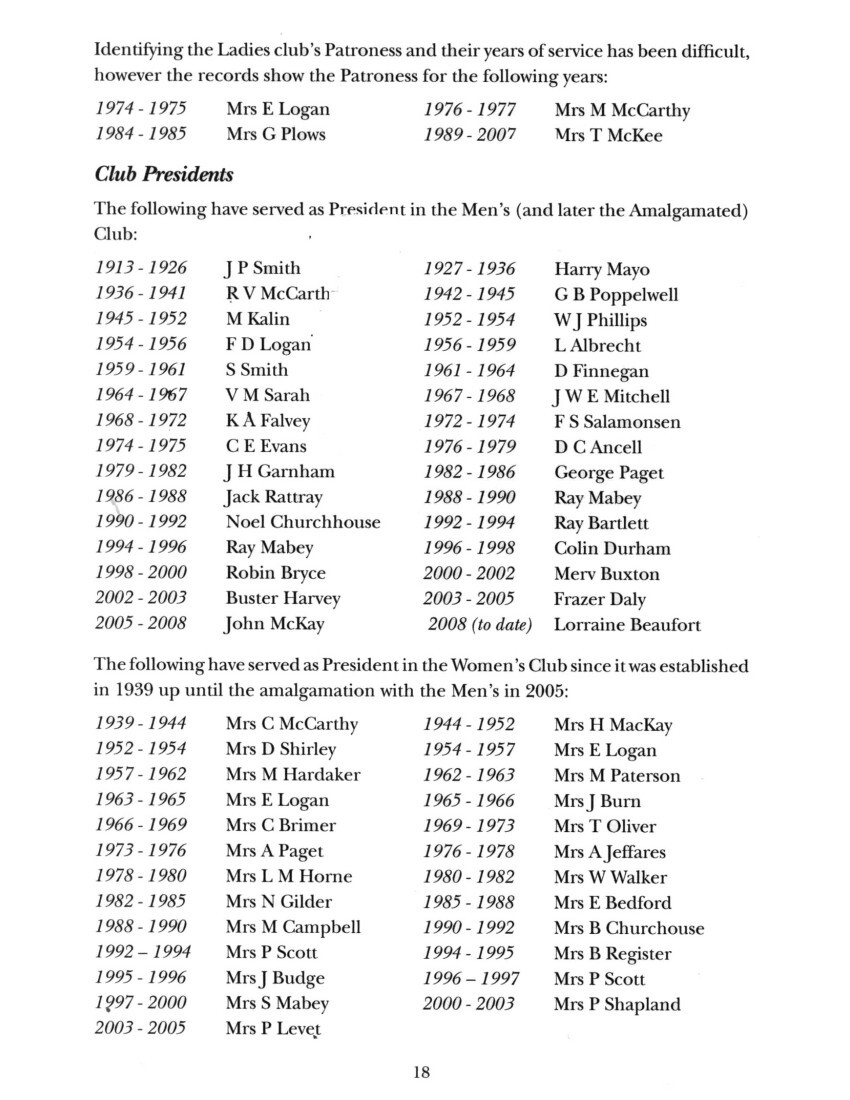
Page 19
Club members 2005-2006.
Membership
It has not been possible to find any records to show the membership during the early years but it seems fairly safe to assume that the initial membership was between 30 and 40 and that it increased slowly, no doubt with minor fluctuations, till 1937 when there were 43 members. This was about the time when No 2 green (B Green) was constructed and the building of the former pavilion commenced. With this activity there was also a rise in membership. The present active period with the laying down of No 3 green and other development work also saw a notable increased from 84 in 1960/61 to 106 in 1963/64.
Older members recall a men’s membership of 250 during the 1990s, making it the largest club in Napier after Omarunui, in Taradale, which had a membership of 300.
In those days the Men’s Saturday roll ups involved using all the three greens. If there was a rink or two spare, the Ladies were able to play. The recognised Ladies roll up day at that time was, Wednesday afternoons, which were well attended.
Our full playing members as at December 2012 is 24 women and 28 men, with 42 Social non Playing Members. Despite vigorous recruiting attempts, there has been a steady decline in numbers of players over recent years, which unfortunately appears to be a universal trend among sporting and other clubs. Membership has gone from 354 in 1985 to 52 in 2012. These being playing members only.

Page 20
Life Membership
The account of membership would not be complete without reference to our valued life members. Election to life membership is the greatest honour a Club can bestow and there are 26 men and 9 women who have been honoured during the past years of our men’s and ladies clubs and since 2005, the amalgamated club. Naturally, on amalgamation, life members of the former clubs had that honour transferred into the amalgamated club.
Awarding of life membership is made at the Annual General Meetings, with the proposal having first been endorsed by the Executive Committee. Nominees must be highly respected by members and have of course “rendered some special service to the Club” in one or many ways such as volunteer work on the Club’s property, by holding office or an important responsibility, promoting the club’s welfare and being a fair and sports minded person.
During the life time of the former Men’s and Women’s clubs and the newer amalgamated club, which spans one century, the following have been honoured with Life Membership for their major contributions:
Men: J P Smith, Harry Mayo, Leslie Steele, R V McCarthy, A B Clegg, G B Poppelwell, F D Logan, M Kalin, J T Johnson, W W Lockwood, K McLeay, E C Pirie, C E MacKinnon, V M Sarah, K A Falvey, E W Lloyd, E G Port, F J Walker, A F Murray, J Plows, H Sweeney, F S Salamonson, G D Paget, D C Ancell, E G Batchelar, R F Bartlett, D J Rattray, N Churchouse, R W Mabey, R J Downing.
Ladies: Mrs C McCarthy, Mrs P Hardacre, Mrs E Logan, Mrs H Hansen, Mrs T Oliver, Mrs A Paget, Mrs B Gallagher, Mrs E Bedford.
Amalgamated Club: Mr R Hart, Mr N Wells, Mrs J Black
All of the above, both ladies and men, have given freely of their time and services. To these members we offer our congratulations, gratitude and admiration.
They are indeed part of the club history and success.
Playing Members
Throughout this history many “Port” bowlers have developed and reached high levels of bowling success. Many have won Hawkes Bay Championship events, represented Hawkes Bay at National Tournament and/or entered in Open provincial and national events.
Many names appear on the Honour Boards displayed in our Pavilion and we invite all attending our Centennial celebrations to take the time now or later to
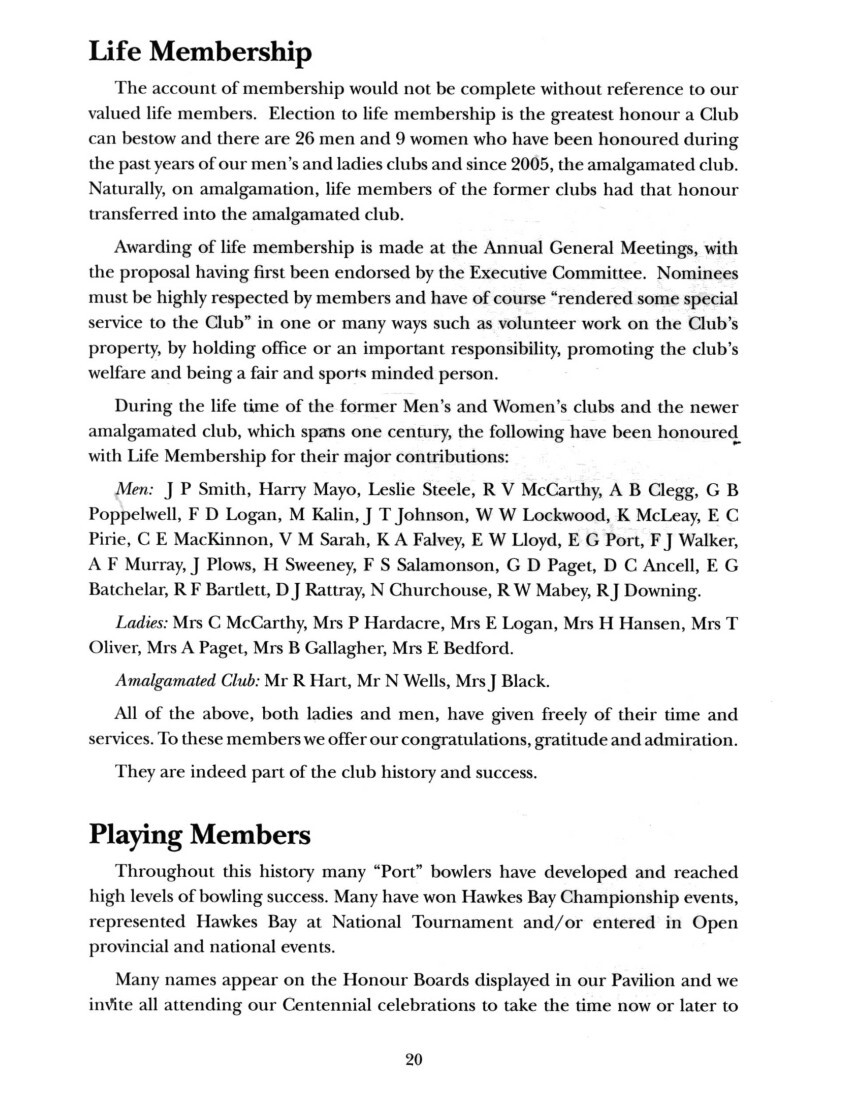
Page 21
study that history. Some success is recorded in photographs on display in the pavilion and in this publication.
Casual Members
In recent years we have promoted casual bowls with the summer Monday night being particularly popular and the Thursday Twilight roll up attracting both members and casual visitors.
Increasingly Special events are being held in our pavilion and guests often try their hand at bowls with some soon displaying their competitive streak.
Social Members
The club has many non-playing social members who display their interest, support and enjoyment in varying ways. The Social Club have Saturday afternoon entertainment and we appreciate their generosity through many donations to the club through funds raised through contributions by members and their popular raffles.
Tournaments
Mini Hetero Triples are played regularly throughout the summer and winter months. The winter games are set on one green with 16 teams and the summer games attract irregular numbers of teams.
Although many of popular women’s, men’s and hetero tournaments are well-known and have been well supported by our fellow bowlers from other clubs, the following significant and special tournaments have been established.
Bennett Cup
This was presented in 1963 for annual play between Hastings Club and Port Ahuriri and was played alternately between the two Clubs until the Hastings Club closed in 2008.
Trades Tournament
This was a popular one day tournament in which teams had to be of the same trade. This began in the early sixties and operated well until support fell away with the last held during 2003.
Cray Tournament
The “Cray” Trophy was presented to the Club in the 1959-1960 season and has
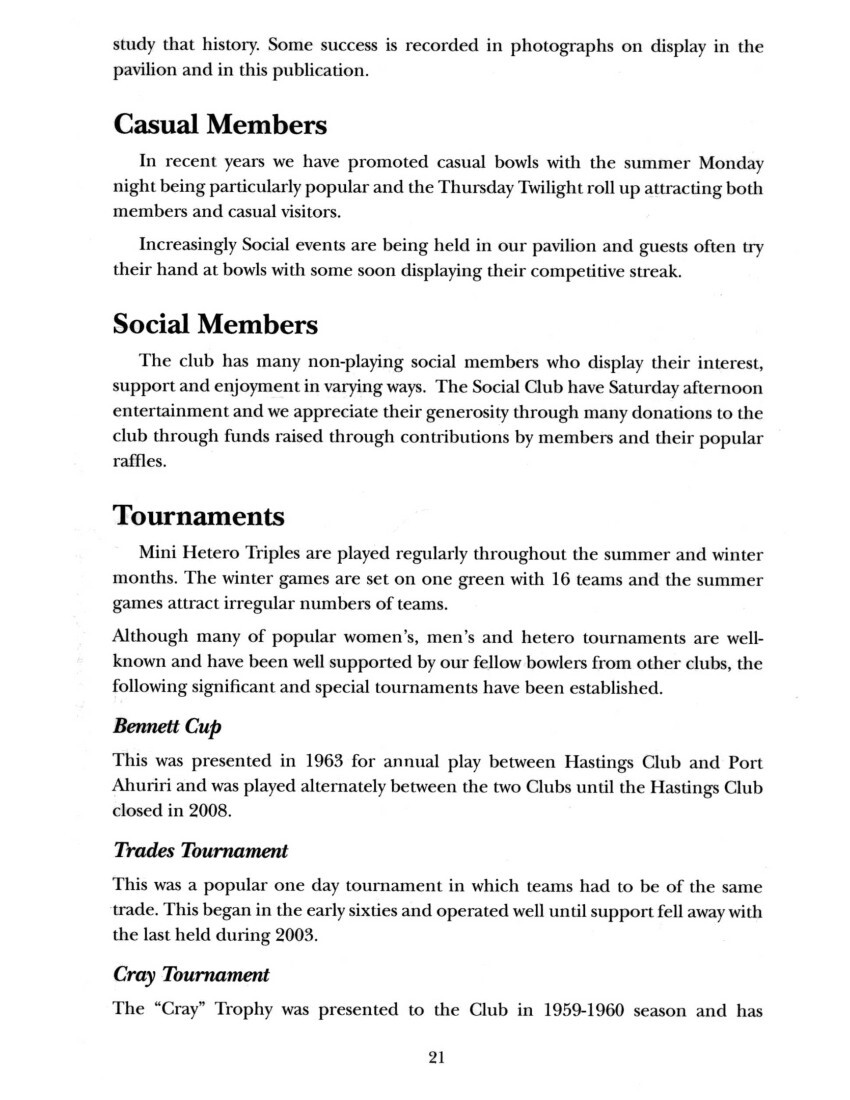
Page 22
celebrated 50 years of play. It is still played today and proves to be a popular tournament in the Bay, attracting up to forty teams annually. The last few years we have had sponsorship from Jack Creagh’s daughter – Judy Richards, who is delighted that her father’s trophy is still being played for.
Women’s Gala
This proves to be another popular tournament, being played in December and attracts up to forty-two teams of four women bowlers. The Lady members of the club work very hard throughout the year crafting, sewing and knitting for it. Apart from being a very enjoyable day for all who enter, this outstanding effort and support, continues to be a very good fund raiser for the Club.
Railway Hetero Pairs Tournament
This tournament began in 2011 – 2012 as an idea from Sea Surgeon to make it the major tournament for the Centennial year. This attracted 42 teams, and the prize money is very attractive with the main sponsor being Voguehaven Rest Home.
Robin Bryce Memorial
This annual Tournament was established in memory of “Boots” Bryce, a popular green keeper for a few years until his sudden and untimely death in 2002. His commitment, attitude and love of the club, epitomised that of many who have served the club very well over the years. Robin served as Club President from 1998 to 2000.
Sponsorship, Grants and Donations
Financial support from many Businesses, Charitable and Gambling Fund Foundations, Groups and Individuals has been a major factor in the success of our bowling club(s). Surely too many to mention in this publication. However the significant long term local supporters which readily come to mind include:
Dunstall’s Funeral Services, Port of Napier, Napier City Council, Eastern and Central community Trust.
To all our supporters, we again record our sincere thanks and appreciation.
Jubilee Celebrations
During the 1963/64 bowling season the Port Ahuriri Bowling Club celebrated their Jubilee being 50 years since it was established. The Jubilee was celebrated with two special events:
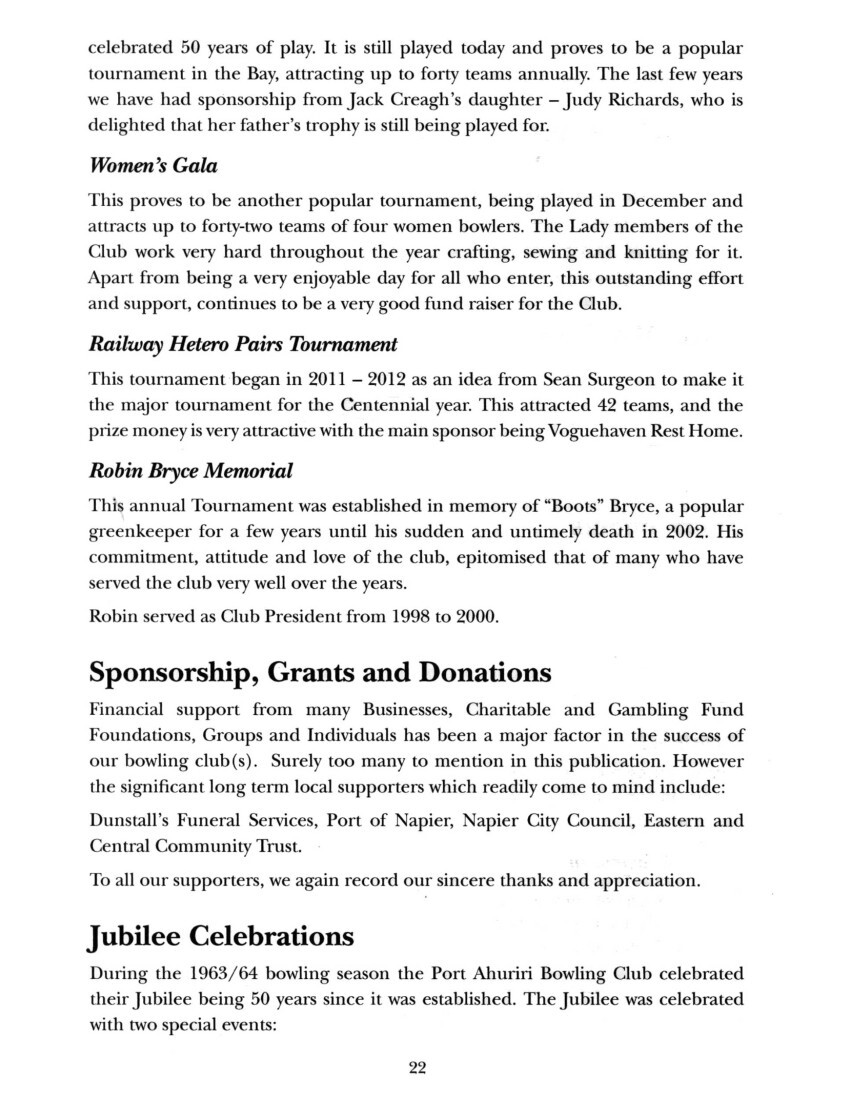
Page 23
The Jubilee Fours Tournament was held on 9/10 November 1963 and was considered an outstanding success and was won by Angus Hardie and his team from the Napier club.
The Jubilee Dinner was held in the James Banquet Lunge on 9th May 1964 and took the form of cocktail hour with dinner and a social following. Prominent artists were engaged to entertain the 109 people who attended and the event was noted as an outstanding success.
Twenty Five years later, during 1988, the Seventy-fifth anniversary of the formation of the club was celebrated with three events:
Men’s open fours and women’s graded fours tournament was held during March.
Centennial Celebrations
As this will possibly be the last Celebration of the “Port Ahuriri Bowling Club Inc” the Executive have decided to hold a week of Celebrations starting with an open, Centennial Bowling Tournament being “The Railway Hetero Pairs” held 2nd and 3rd of February 2013, on the following Tuesday will be the Hetero Mini Triples, then on the Friday the Centennial Registrations – following with the Centennial Celebration on Saturday 9th February 2013 which will begin with a ‘Formal Welcome’ by our President – Mrs Lorraine Beaufort and the ‘Official Opening’ by the Deputy Mayor – Mrs Kathie Furlong. This will be followed by lunch then a full afternoon programme, including bowls, photographs and a local historian reflecting on the history of the “Port” Ahuriri area. A “Celebration Dinner” is being held at our Club on Saturday evening. Sunday’s programme includes a “Chit Chat” Roll up, drinks and light refreshments.
The Future
Due to dwindling numbers of active bowlers, the current club is to be wound up on 31 August 2013. Our sister club, Bowls Wairere, will also wind up and members from both clubs will be invited to join a new club, which is to operate at our present location. This is in a sense, an amalgamation of the two clubs, under another name, which at this stage is most likely to be named “Port United Bowling Club Incorporated.”
This will surely involve a larger number of players and bring together the various resources from each club. This opportunity should ensure that in the foreseeable future, lawn bowls will continue to be played on the attractive “Port” property. The greens and facilities will continue to be enjoyed by members as well as the increasing numbers of casual members, plus our many and loyal bowlers from other clubs.

Page 24
Back Row: Bryan Wright, Lesley Gillon, Bob Clark, Jane Ferguson, Buster Harvey.
Front Row: Molly Wylie, Lorraine Beaufort, Maggie Smith, Pauline Bartlett.
Club Officers in Centennial year 2012/2013
Patron: Ray Bartlett
President: Lorraine Beaufort
Vice President: Bryan Wright
Secretary/Treasurer: Buster Harvey
Committee: Maggie Smith, Lesley Gillon, Molly Wylie, Jane Ferguson and Bob Clark
Catering Manager: Pauline Bartlett
Bar Manager: Lorraine Beaufort
Green’s Superintendent: Geoff McGarva
Life Members: Tess Oliver, Edith Bedford, Ray Bartlett, Noel Churchouse, Ray Hart and Jocelyn Black

Non-commercial use

This work is licensed under a Attribution-NonCommercial 3.0 New Zealand (CC BY-NC 3.0 NZ).
Commercial Use
Please contact us for information about using this material commercially.Can you help?
The Hawke's Bay Knowledge Bank relies on donations to make this material available. Please consider making a donation towards preserving our local history.
Visit our donations page for more information.
Description
Surnames in this book –
Albrecht, Alexander, Ancell, Barlow, Bartlet, Batchelar, Beaufort, Bedford, Black, Brimer, Bryce, Budge, Burn, Buxton, Campbell, Carlaw, Churchouse, Clark, Clegg, Cox, Creagh, Crowley, Daly, Dolbel, Downing, Durham, Epps, Evans, Falvey, Ferguson, Finnegan, Gallagher, Garnham, Gilder, Gillon, Hale, Hansen, Hardacre, Hardaker, Hart, Harvey, Horne, Jeffares, Kalin, Kessel, Levet, Lloyd, Lockwood, Logan, Mabey, MacKay, MacKinnon, Martin, Mayo, McCarthy, McGarva, McKay, McKee, McLeay, Mitchell, Montgomery, Murray, Myhill, Oliver, Paget, Paterson, Phillips, Pirie, Plows, Poppelwell, Port, Prebble, Rattray, Richards, Salamonson, Sarah, Scott, Shapland, Sheehan, Shirley, Smith, Smith, Smith, Steele, Sweeney, Thompson, Walker, Wells, White, Wright, Wylie

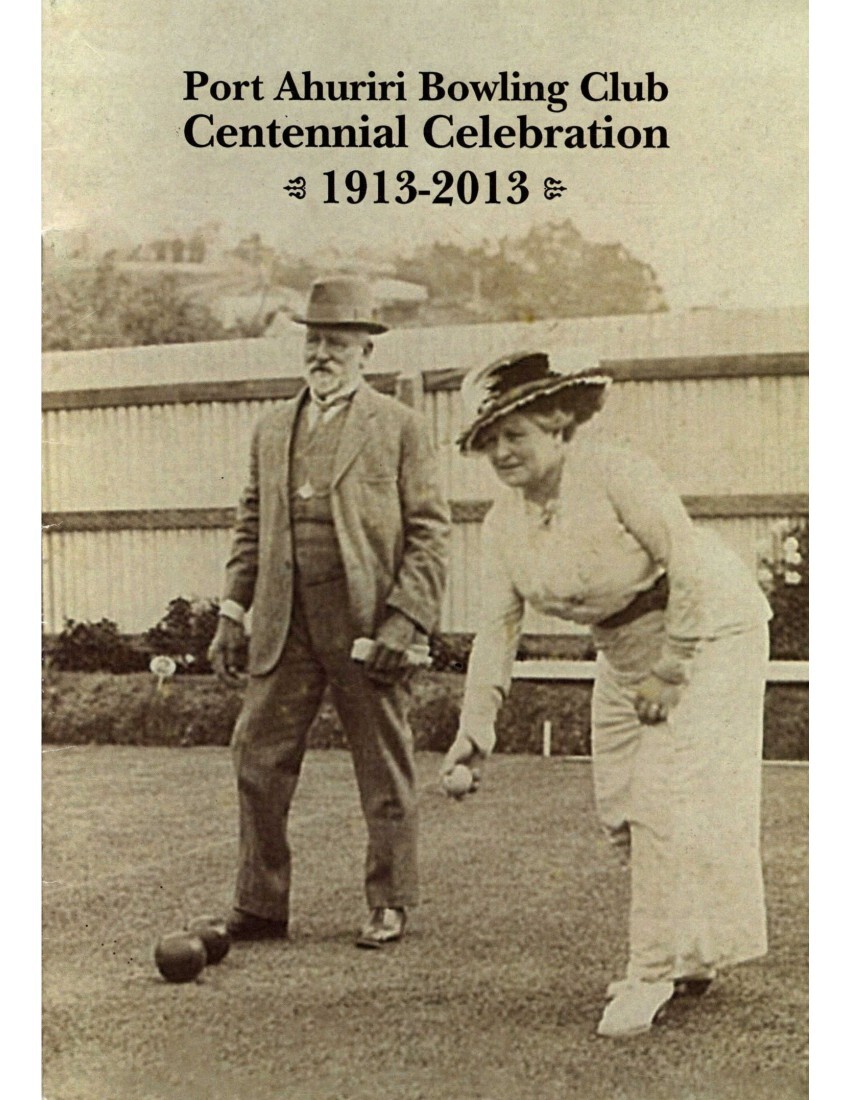
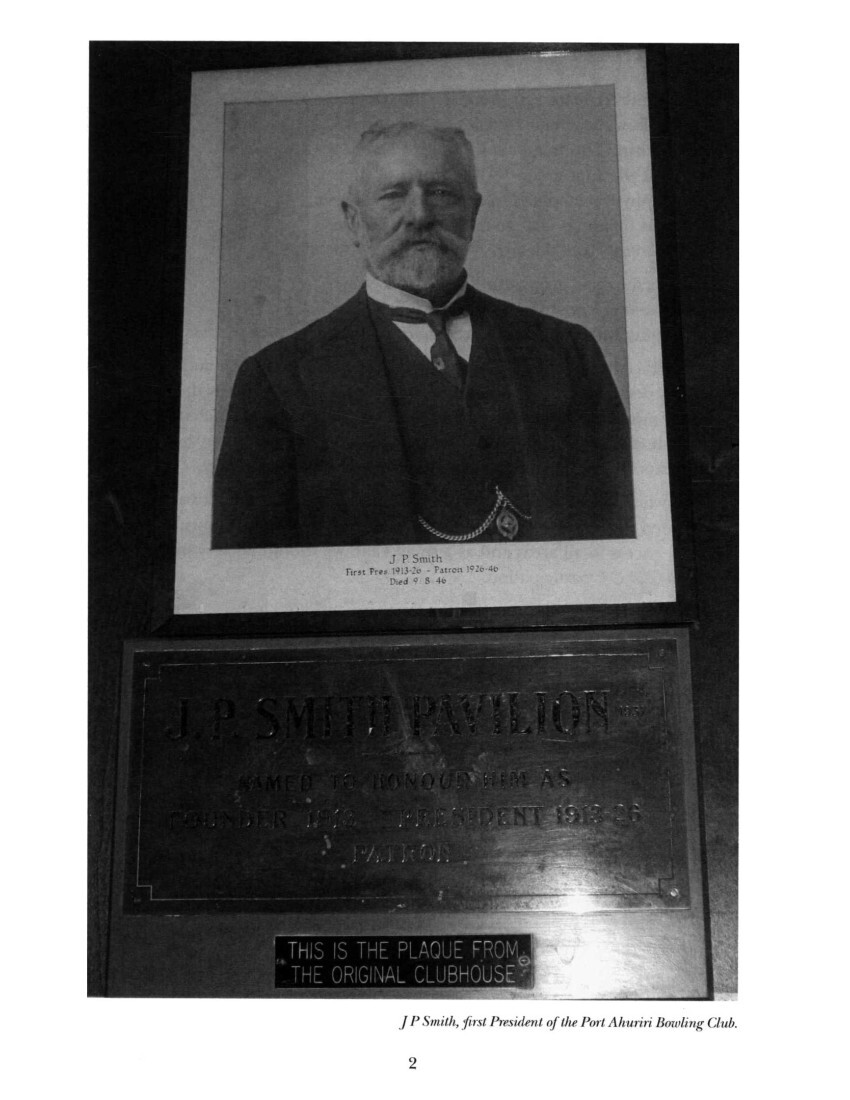
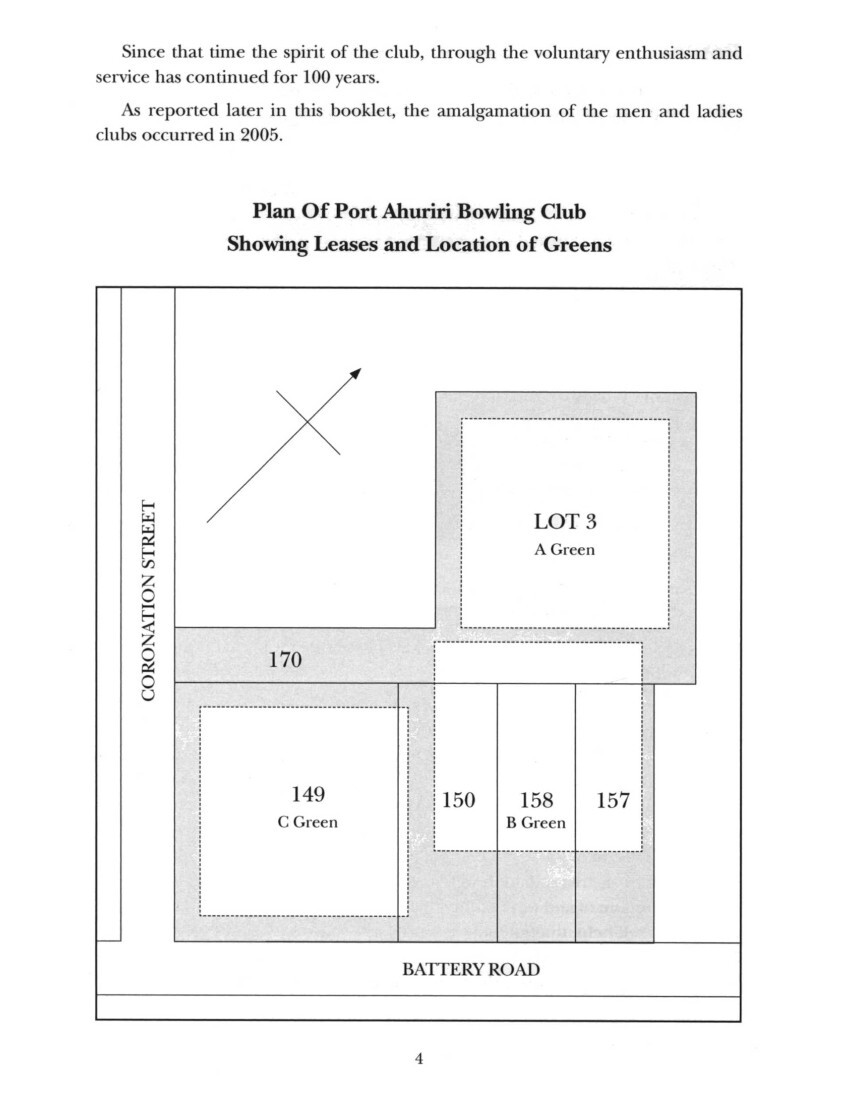
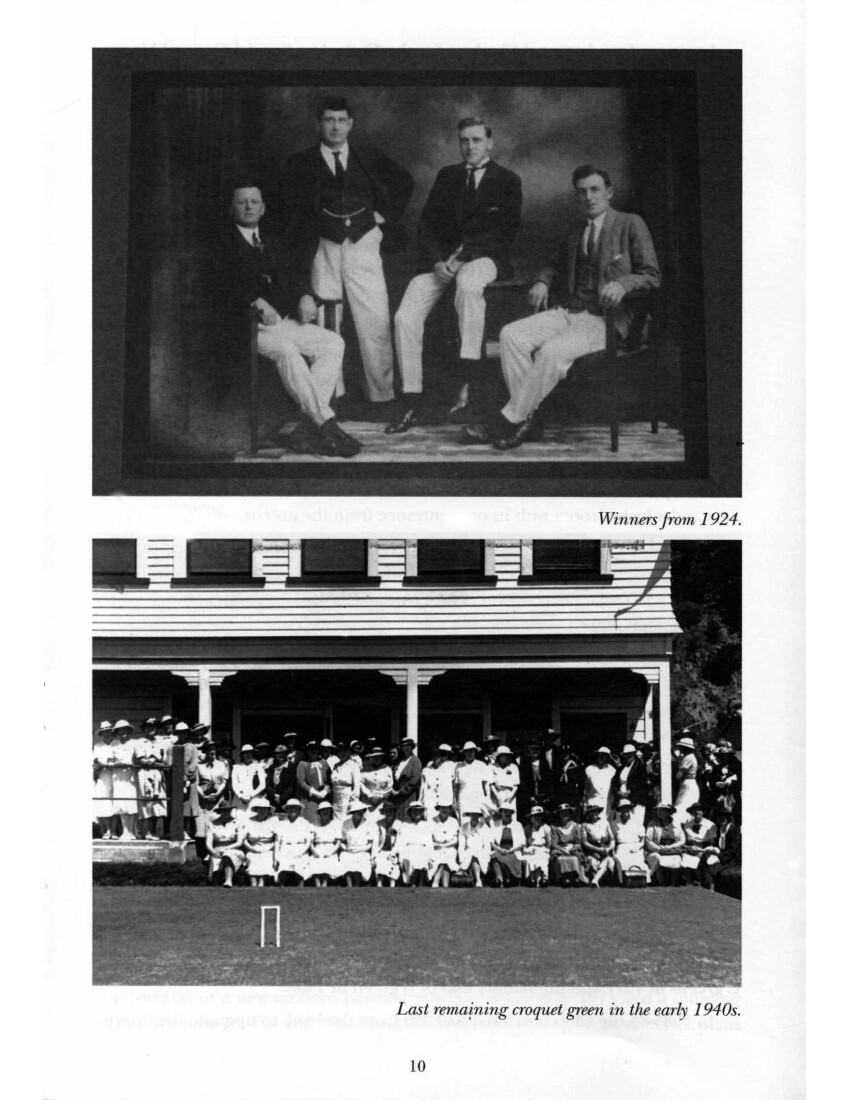
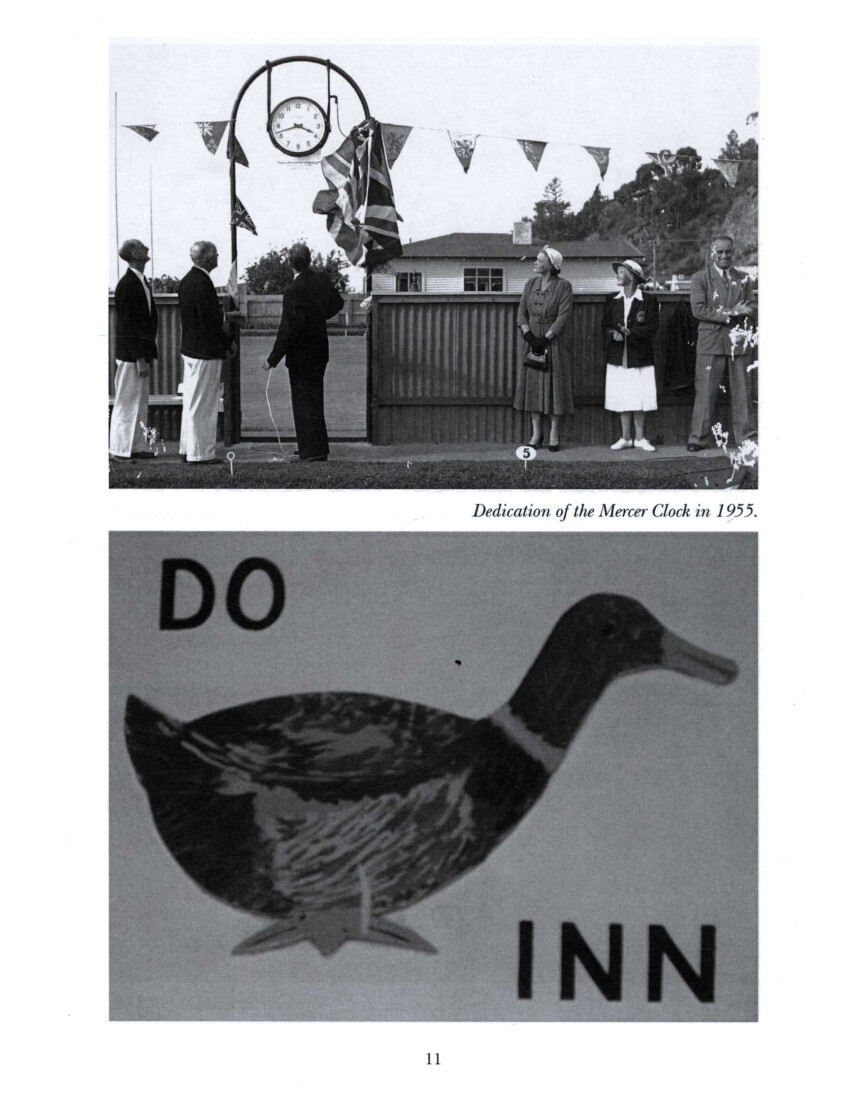
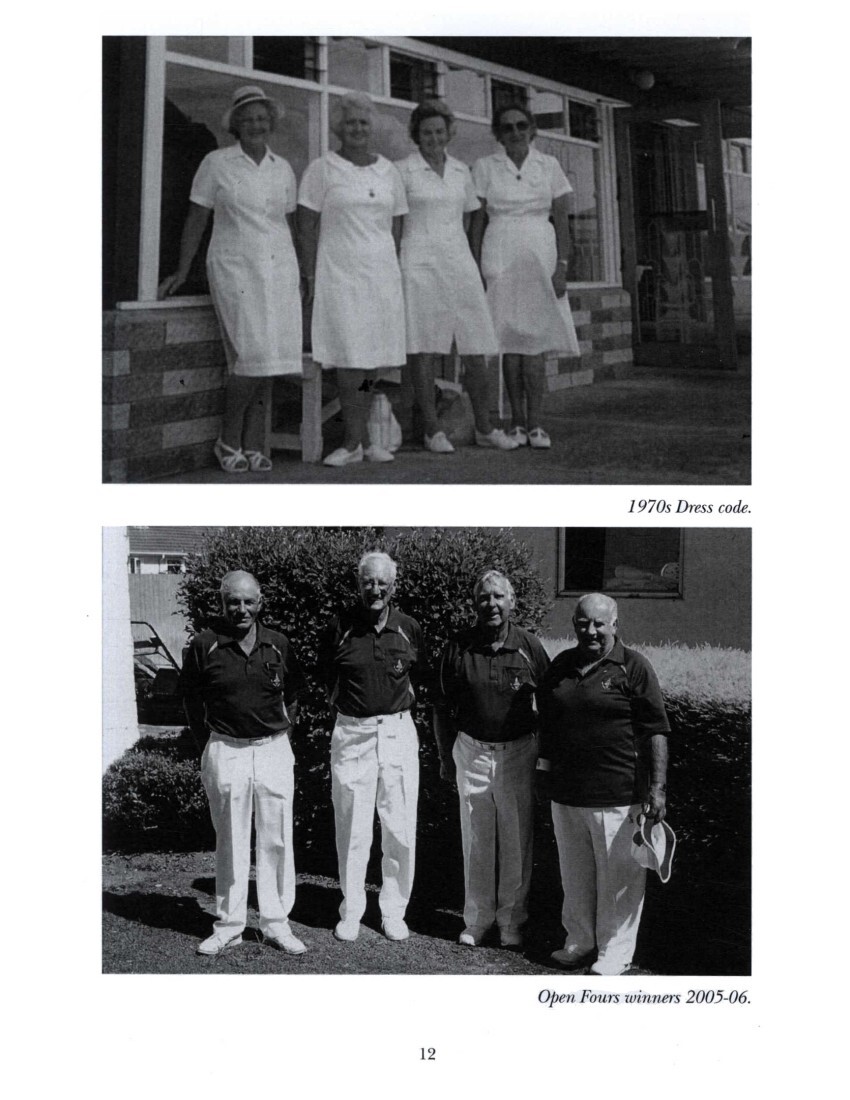
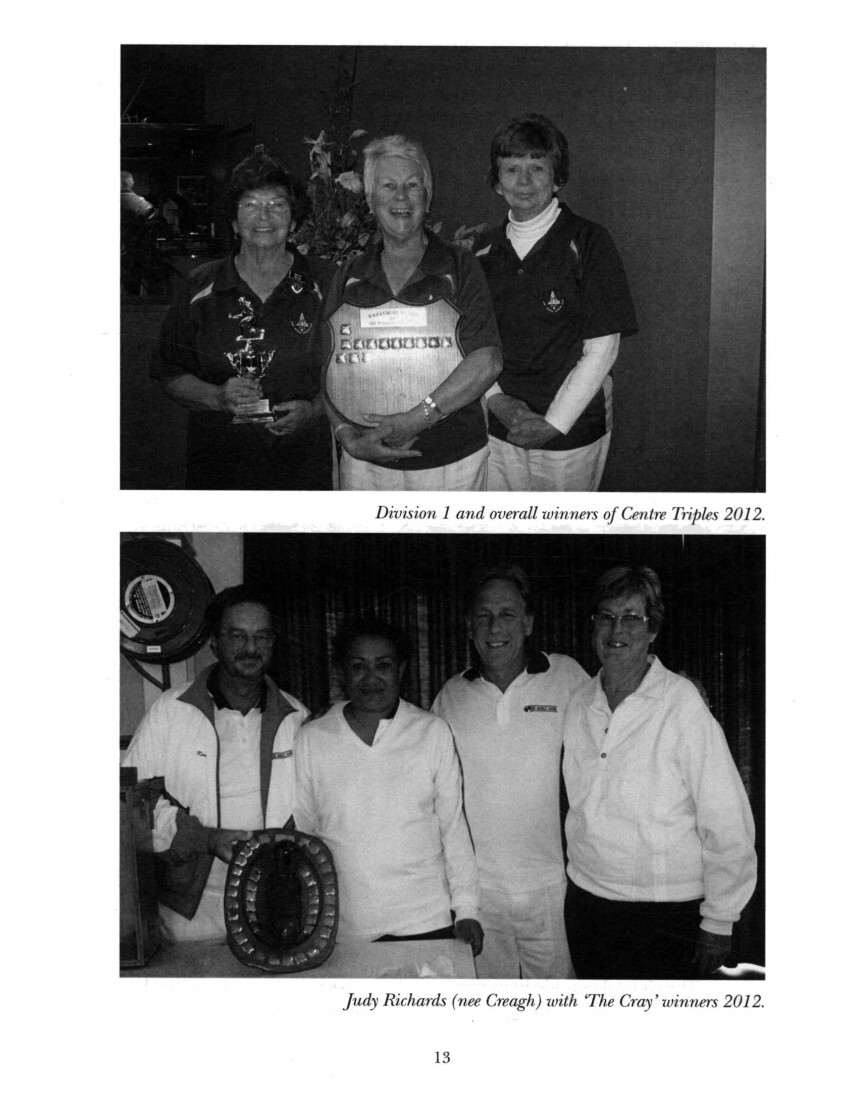
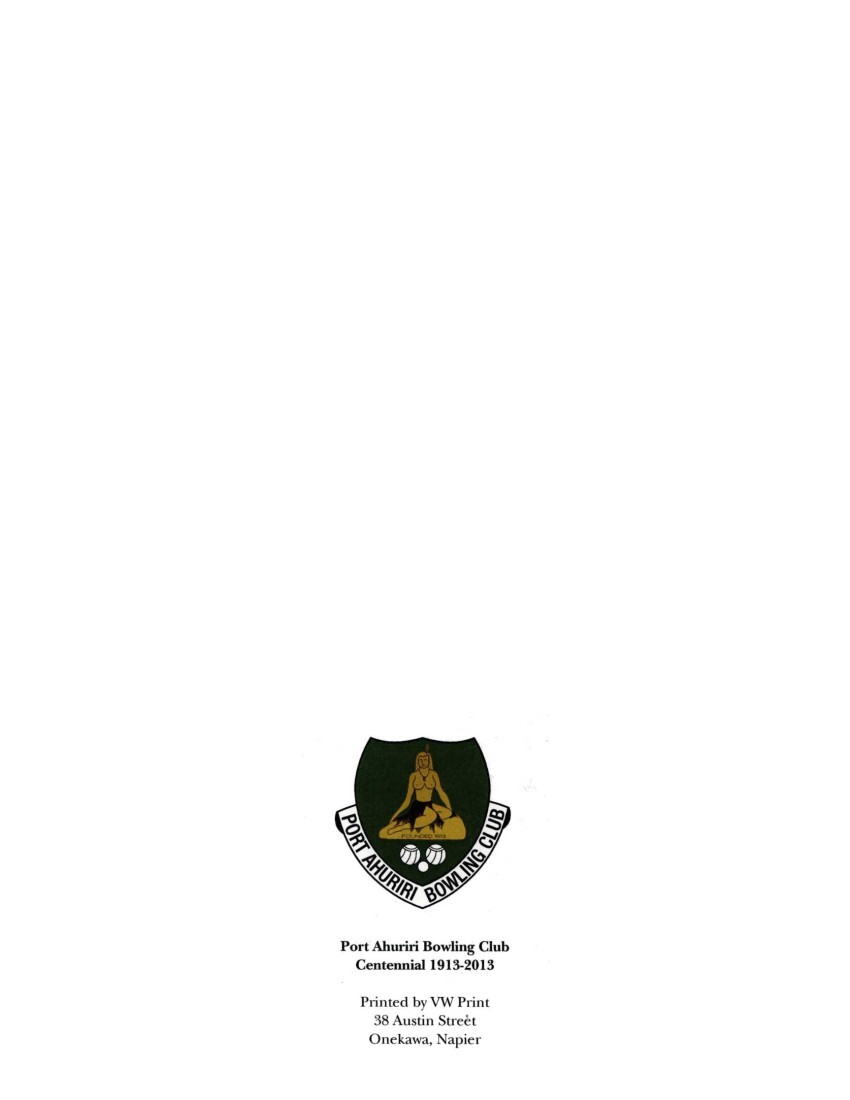









Do you know something about this record?
Please note we cannot verify the accuracy of any information posted by the community.